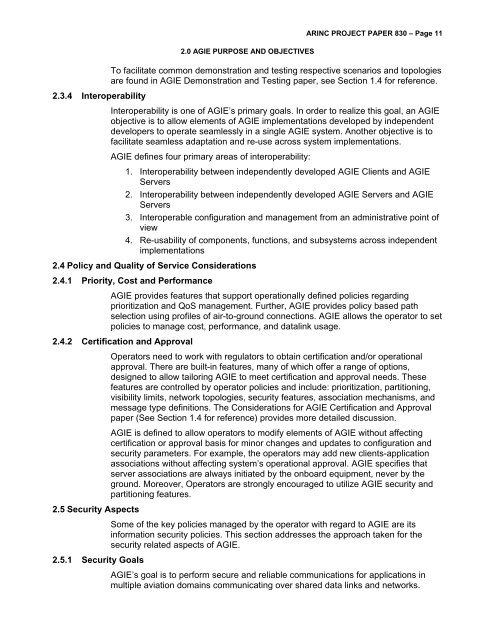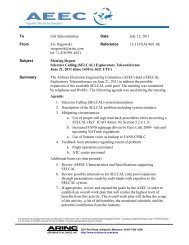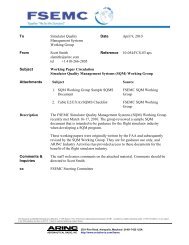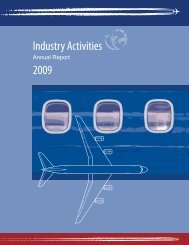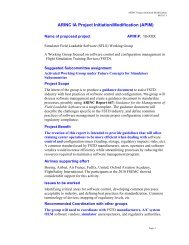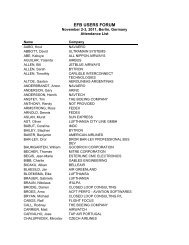(AGIE) Using Internet Protocols - Aviation Committees - AEEC - AMC
(AGIE) Using Internet Protocols - Aviation Committees - AEEC - AMC
(AGIE) Using Internet Protocols - Aviation Committees - AEEC - AMC
- No tags were found...
Create successful ePaper yourself
Turn your PDF publications into a flip-book with our unique Google optimized e-Paper software.
2.0 <strong>AGIE</strong> PURPOSE AND OBJECTIVESARINC PROJECT PAPER 830 – Page 11To facilitate common demonstration and testing respective scenarios and topologiesare found in <strong>AGIE</strong> Demonstration and Testing paper, see Section 1.4 for reference.2.3.4 InteroperabilityInteroperability is one of <strong>AGIE</strong>’s primary goals. In order to realize this goal, an <strong>AGIE</strong>objective is to allow elements of <strong>AGIE</strong> implementations developed by independentdevelopers to operate seamlessly in a single <strong>AGIE</strong> system. Another objective is tofacilitate seamless adaptation and re-use across system implementations.<strong>AGIE</strong> defines four primary areas of interoperability:1. Interoperability between independently developed <strong>AGIE</strong> Clients and <strong>AGIE</strong>Servers2. Interoperability between independently developed <strong>AGIE</strong> Servers and <strong>AGIE</strong>Servers3. Interoperable configuration and management from an administrative point ofview4. Re-usability of components, functions, and subsystems across independentimplementations2.4 Policy and Quality of Service Considerations2.4.1 Priority, Cost and Performance<strong>AGIE</strong> provides features that support operationally defined policies regardingprioritization and QoS management. Further, <strong>AGIE</strong> provides policy based pathselection using profiles of air-to-ground connections. <strong>AGIE</strong> allows the operator to setpolicies to manage cost, performance, and datalink usage.2.4.2 Certification and ApprovalOperators need to work with regulators to obtain certification and/or operationalapproval. There are built-in features, many of which offer a range of options,designed to allow tailoring <strong>AGIE</strong> to meet certification and approval needs. Thesefeatures are controlled by operator policies and include: prioritization, partitioning,visibility limits, network topologies, security features, association mechanisms, andmessage type definitions. The Considerations for <strong>AGIE</strong> Certification and Approvalpaper (See Section 1.4 for reference) provides more detailed discussion.<strong>AGIE</strong> is defined to allow operators to modify elements of <strong>AGIE</strong> without affectingcertification or approval basis for minor changes and updates to configuration andsecurity parameters. For example, the operators may add new clients-applicationassociations without affecting system’s operational approval. <strong>AGIE</strong> specifies thatserver associations are always initiated by the onboard equipment, never by theground. Moreover, Operators are strongly encouraged to utilize <strong>AGIE</strong> security andpartitioning features.2.5 Security AspectsSome of the key policies managed by the operator with regard to <strong>AGIE</strong> are itsinformation security policies. This section addresses the approach taken for thesecurity related aspects of <strong>AGIE</strong>.2.5.1 Security Goals<strong>AGIE</strong>’s goal is to perform secure and reliable communications for applications inmultiple aviation domains communicating over shared data links and networks.


